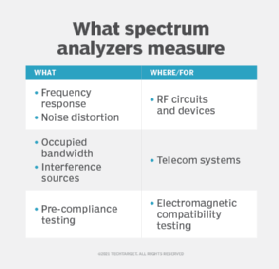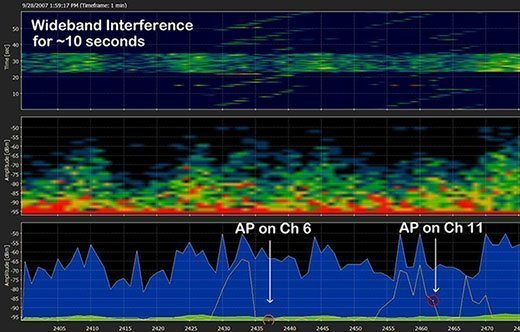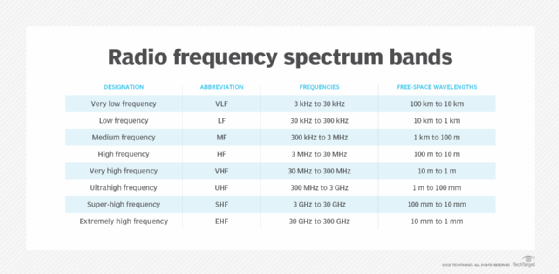spectrum analyzer
A spectrum analyzer is a device that measures and displays Signal amplitude (strength) as it varies by frequency within its frequency range (spectrum). The frequency appears on the horizontal (X) axis, and the amplitude is displayed on the vertical (Y) axis. It looks like an oscilloscope, and in fact, some devices can function as either oscilloscopes or spectrum analyzers.
Importance of spectrum analyzers
Radio frequency (RF) signals and wireless communications are ubiquitous today thanks to Wi-Fi, mobile networking and communications, wireless internet of things device sensors, traditional radio, RADAR and more. To test and design such circuits and systems, it is useful to see the entire signal spectrum and other factors like spurious signals, noise, modulated signal width, etc.
Devices like swept spectrum analyzers and vector signal analyzers do not provide such capabilities. Also, they provide only snapshots of the signal in either the frequency or modulation domain, which cannot describe the dynamic and transient nature of modern RF signals.
This is where spectrum analyzers are valuable.
What do spectrum analyzers measure?
A spectrum analyzer displays a spectrum of signal amplitudes on different frequencies. It enables analysis that determines whether signals fall within required limits. It displays spurious signals, complex waveforms, rare short-duration events and noise. Spectrum analyzers can also analyze transient signals, capture burst transmissions and glitches, and show if stronger signals are masking weaker ones.
These devices are frequently used to examine the dynamic frequency spectrum of modern RF and audio signals that change over time. They display the individual elements of signals and the performance of the circuits producing them. Organizations also use them to determine what modifications may be needed to reduce interference and so improve the performance of Wi-Fi systems and wireless routers.

Types of spectrum analyzers
There are several different kinds of spectrum analyzers.
Swept-tuned or superheterodyne
A swept-tuned, or superheterodyne, spectrum analyzer down-converts part of the input signal to the center frequency of a bandpass filter by running a voltage-controlled oscillator across a range of frequencies. This enables the full frequency range of the device to be analyzed. In this case, the resolution bandwidth is closely related to the minimum bandwidth detectable by the device and is controlled by the bandpass filter. A smaller bandwidth yields a higher spectral resolution, and vice versa.
Fast Fourier transform
Some digital spectrum analyzers use Fourier transforms -- a way of decomposing a signal into its individual frequencies. These analyzers need a sampling frequency at least twice the bandwidth because frequency resolution is the inverse of the time over which the wave is measured and Fourier transformed.
Real-time analyzers
Real-time analyzers collect real-time bandwidth and sample the incoming RF spectrum in a limited span of time, converting the information using the fast Fourier transform (FFT) algorithm. Because it's real-time data collection, there is no blind time, and there are no gaps in the calculated RF spectrum.
Audio
Spectrum analyzers can also be used in the audio spectrum, displaying volume levels of frequency bands audible to humans. This method is aimed at analyzing the harmonics of an audio signal. Once known as wave analyzers, these types of spectrum analyzers are widely used by sound engineers and can run on almost any computer equipped with a sound card.
Spectrum analyzers: Advantages and disadvantages
With swept-tuned analyzers, there is a tradeoff between how rapidly the display can update a full frequency span and resolution. With weak signals, a pre-amplifier is needed before analysis.
FFT analyzers can strain the capabilities of analog-to-digital converters. They also require significant processing power, limiting the possible frequency range that can be analyzed.
Real-time FFT analyzers offer good resolution and reduce sampling gaps, however.

How spectrum analyzers work
With most spectrum analyzers, users can set a start and stop frequency, as well as a center frequency halfway. These are also the axis for the frequency used to determine the span, aka passband -- for example, the range between the start and stop frequencies. The spectrum analyzer measures the radio noise floor and analyzes how close two signals can be while still being resolved into two separate peaks.
It uses a linear scale for signal frequency and a logarithmic or decibel scale for amplitude. The latter enables the device to see and display signals with large amplitude differences on the same screen.
A spectrum analyzer's interface can be connected to a wireless receiver or personal computer to enable visual detection and analysis of electromagnetic signals over a defined band of frequencies. Called panoramic reception, this can help determine the frequencies of interference sources to wireless networking equipment, like Wi-Fi and wireless routers.
Real-time spectrum analyzers examine signals using real-time digital signal processing (DSP), which is done prior to storage in memory. This enables users to dive deeper into signals and discover events that are invisible to other kinds of devices. They can also perform signal conditioning and calibration and extensively analyze the data in memory using batch processing.
In real-time spectrum analyzers, DSP and a control processor that controls the device display provide advanced capabilities that swept-tuned spectrum analyzers and vector signal analyzers lack. They also enable the automation of several routines.

Applications of spectrum analyzers
On the display of a spectrum analyzer, output signals at frequencies other than the intended communications frequency appear as vertical lines (pips). This makes them useful to determine whether a wireless transmitter is working according to government-defined standards for emissions purity, i.e., whether the transmitter is staying within its allocated frequency band and not causing interference in other bands.
In addition to RF design and testing, spectrum analyzers are also useful for electronic circuit design and electronics manufacturing and repair.
A real-time spectrum analyzer is particularly helpful for the following:
- Wi-Fi testing
- voice and data communications, e.g., cellular radio
- digital video
- radar test analysis
- interference hunting
- signal spectrum management






